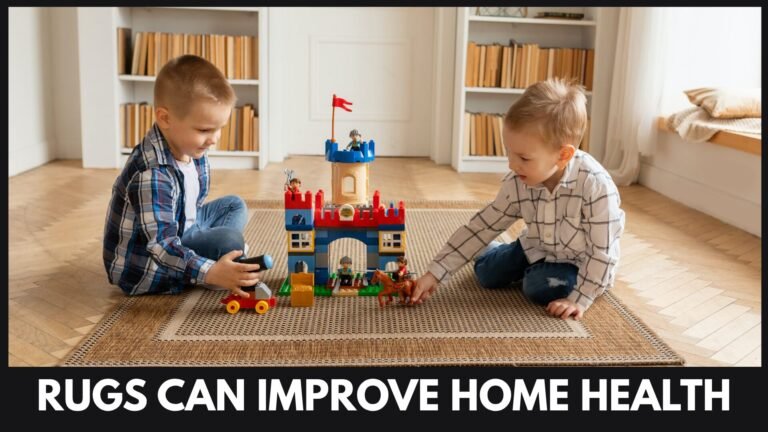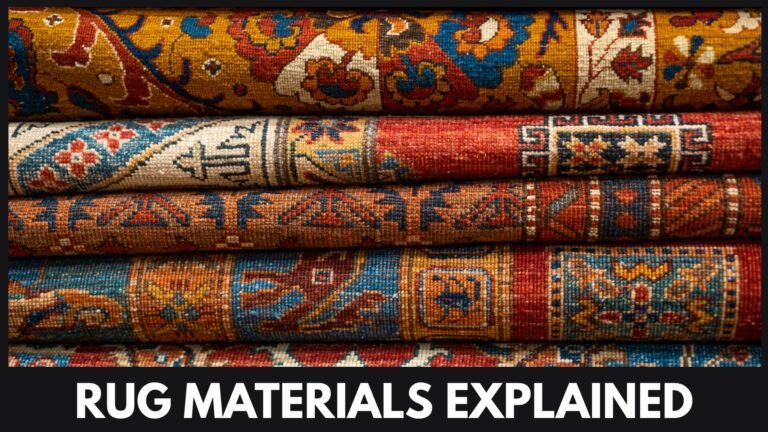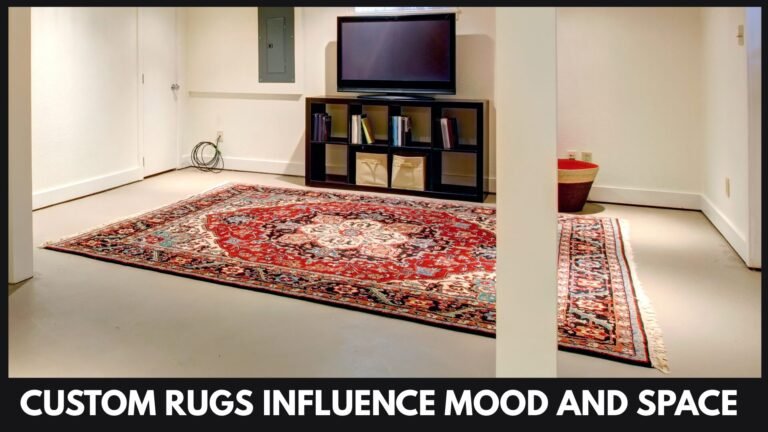
Caring for Your Custom Rug: Maintenance and Cleaning Tips
A custom rug is not only a piece of art for your home but also a functional element that adds warmth, comfort, and style to any room. When you invest in a custom rug, you expect it to maintain its beauty and durability over the years. However, regular maintenance is required to keep it looking fresh and to extend its life. Whether your rug is made from fine wool, luxurious silk, or modern synthetic fibers, proper care can prevent issues like dirt buildup, stain damage, and premature wear.
Table of Contents
1. Regular Vacuuming: The First Step in Maintenance
Daily life in busy households often leads to dust, dirt, and debris accumulating on your rug. Regular vacuuming is vital to prevent these small particles from working their way deep into the fibers. Here are some important points to consider:
- Frequency: In high-traffic areas such as living rooms and hallways, it is best to vacuum at least twice a week. In low-traffic areas like bedrooms, once a week might be sufficient.
- Vacuum Settings: Use a vacuum cleaner with adjustable settings. For delicate rugs, a suction-only mode or a brushless head is ideal since rotating brushes or beater bars may pull at the fibers and cause damage.
- Direction Matters: Vacuum in different directions occasionally. This ensures all sides of the rug receive attention, and it helps maintain the natural pile direction.
- Spot Attention: When vacuuming, pay special attention to areas that receive higher foot traffic and corners where dirt tends to accumulate.
- Rug Pads and Vacuuming: If your custom rug is placed on a rug pad, make sure the pad is also cleaned regularly. A dirty pad can transfer dust back onto your rug.
Regular vacuuming prevents dirt from settling in and keeps the rug’s fibers upright. This not only enhances the rug’s appearance but also maintains its texture and softness over time.
2. Stain Removal: Act Quickly and Carefully
Accidents happen, and when they do, how you respond can make all the difference in saving your rug from permanent damage. Here are some guidelines for effective stain removal:
- Immediate Action: The sooner you treat a spill, the better the chances of preventing a stain. Blot the spill gently with a clean, dry cloth. Avoid rubbing as it can push the liquid deeper into the fibers.
- Mild Cleaning Solutions: For many stains, a mild solution of water and gentle detergent works well. Test the solution on a small, hidden area first to ensure it does not affect the color or texture.
- Know Your Fiber: Different materials require different treatments. Wool rugs, for example, are naturally stain-resistant due to their oils, but they can still suffer from water damage if over-wet. Silk is more sensitive and may need professional care for stubborn stains, while synthetic fibers often handle gentle cleaning very well.
- Blot, Don’t Scrub: When removing a stain, use blotting motions rather than scrubbing. Scrubbing can damage the fibers or cause the stain to spread.
- Dry Properly: After cleaning, allow the rug to dry thoroughly. Avoid placing a damp rug in a humid area, as this could lead to mildew formation. If possible, air dry the rug in a shaded, well-ventilated space.
For deep or stubborn stains that do not respond to your best home methods, it is wise to call in professionals who have the right equipment and expertise to handle delicate or intricate designs.
3. When to Call a Professional Cleaner
Even with routine care, your rug may eventually require a deep clean that goes beyond everyday maintenance. Professional cleaning services are trained to handle custom rugs with special care. Here are situations when it is time to call a professional:
- Heavy Stains or Odors: If your home experiences frequent spills, pet accidents, or the rug has developed a persistent odor, professional cleaning can restore its freshness and remove deeply embedded dirt.
- Annual or Biannual Cleaning: As part of your long-term maintenance plan, consider having your rug professionally cleaned once every 12 to 24 months. Professional cleaning helps remove dust and allergens that regular vacuuming might miss.
- Damage from Water or Flooding: In the event of significant water exposure, such as during heavy rains or a flood, professional intervention is necessary to prevent mold growth and to properly dry and treat the fibers.
- Conservation of Fine Materials: High-end rugs made from silk or delicate wool require specialized cleaning techniques. If you are unsure about cleaning methods or if the stain is in a prominent area, professionals are better equipped to handle the situation without causing damage.
- Restoration Work: Over time, wear and tear may lead to signs of damage like fraying or uneven pile. Professional cleaners and restorers can repair small sections to ensure the rug retains its original beauty.
Remember, improper cleaning techniques might worsen the damage. When in doubt, it is safer and more cost-effective in the long run to seek a professional’s help rather than trying harsh chemicals or untested methods at home.
4. Daily and Seasonal Maintenance Tips
Keeping your custom rug in optimal condition is an ongoing process that involves both daily routines and seasonal adjustments. Here are some strategies to maintain its appearance year-round:
- Daily Care in Busy Homes: Even if your rug does not require daily vacuuming, make sure to shake out small debris in high-traffic areas. A quick pass with a hand broom or shake outdoors can remove loose dust.
- Seasonal Rotation: In rooms where the rug is exposed to direct sunlight, consider rotating it every few months. This reduces the risk of uneven fading or wear, especially in areas where the rug’s colors are exposed to harsh sunlight.
- Avoid High Heels and Sharp Objects: In areas with heavy foot traffic, try to minimize the wear caused by high heels or objects with sharp edges. Adding a protective rug pad can also help reduce friction and wear.
- Window Treatments: In rooms that receive abundant sunlight, use curtains or blinds to reduce direct exposure. Prolonged sunlight can fade colors over time, which is particularly true for natural dyes found in traditional custom rugs.
- Regular Checking: Periodically inspect your rug for any loose threads, snags, or areas of wear. Early detection of minor issues means you can address them before they escalate into larger problems.
Following a consistent maintenance routine will not only keep your custom rug looking vibrant but also extend its life and preserve your investment.
5. Storage and Handling Tips
There are times when you may need to store or move your custom rug, whether due to a change in decor, renovations, or seasonal adjustments. Proper storage and handling play a key role in protecting your rug:
- Rolling vs. Folding: For storage, it is best to roll the rug rather than fold it. Folding can create creases that are hard to remove, while rolling prevents permanent bends.
- Use Protective Covers: Wrap your rug in a breathable cloth or a cotton sheet before storing it in a dry, cool place. Avoid plastic covers that may trap moisture and cause mildew.
- Avoid Direct Sunlight: If you need to store your rug in a room with windows, ensure it is placed away from direct sunlight, which could cause fading or weaken the fibers.
- Keep it Elevated: Do not store your rug on a bare floor for extended periods. Instead, use pallets or a clean, breathable surface to help prevent moisture absorption from the ground.
- Periodic Checks: Even while in storage, check your rug every few months for any signs of damage, mold, or pest infestation. Regular inspection can prevent small issues from growing into major problems.
Safe storage and careful handling are essential parts of maintaining your rug’s quality over time.
6. Making Maintenance a Part of Your Routine
Consistency is key when it comes to maintenance. Integrating care practices into your daily life can be straightforward with a little planning:
- Set a Schedule: Mark your calendar for regular vacuuming and seasonal professional cleaning. A structured routine ensures that maintenance does not fall by the wayside.
- Keep Cleaning Supplies Handy: Have a designated set of cleaning materials—such as a soft cloth, mild detergent, and a vacuum cleaner with adjustable settings—readily available near the rug.
- Educate Family Members: Make sure that everyone in the household understands how to treat spills or avoid habits that might damage the rug, such as dragging heavy objects over it.
- Follow Manufacturer Guidelines: If your custom rug came with care instructions, follow them closely. These guidelines are usually tailored to the specific materials and design of your rug.
- Regular Inspections: Build in a routine inspection every few months to look for signs of dirt, fraying, or other issues. Early detection is always better than a costly repair later.
By establishing a clear maintenance plan, you add a layer of protection to your custom rug and help it continue to look its best.
7. How Carpetsandrug Supports Your Rug Care Journey
At Carpetsandrug, the focus is not just on making and delivering high-quality custom rugs; it is also on ensuring that customers can maintain their pieces effectively. The team is ready to provide support and guidance at every step:
- Personalized Advice: Based on your specific rug’s material and design, the experts can offer tailored cleaning and maintenance tips.
- Quality Assurance: The rugs produced come with care instructions and recommended practices to keep them in good condition.
- Customer Support: Whether you need guidance on handling a stubborn stain or advice on storage, Carpetsandrug’s customer service is there to help.
- Access to Professional Cleaners: If your rug needs extra care, the team can suggest trusted professionals who specialize in cleaning high-quality custom rugs.
- Warranty and Aftercare: A reliable provider stands by its products and offers support for repair or professional cleaning if issues arise during routine maintenance.
Having reliable support from a respected company can make all the difference, ensuring that your custom rug remains a cherished addition to your home for many years.
8. Eco-Friendly and Ethical Care
More and more people are mindful of both the environment and ethical practices when caring for their possessions. When it comes to rug maintenance, consider the following tips:
- Eco-Friendly Cleaners: Many modern cleaning solutions are made from natural ingredients. Using these products can reduce the impact on both your rug and the environment.
- Reduced Chemical Use: Instead of harsh chemicals, opt for homemade solutions, such as a mixture of water and a few drops of mild detergent. This is usually effective for everyday cleaning.
- Proper Disposal: If your rug does eventually need repair or replacement, look for recycling or proper disposal methods so that the materials do not harm the environment.
- Sustainable Practices: Buying a high-quality custom rug means that, over time, you will not have to replace it frequently. This is an eco-friendly choice that reduces waste.
Considering the long-term care of your rug also supports sustainable living practices, ensuring that your investment continues to benefit both you and the environment.
9. Budget-Friendly Maintenance Ideas
Taking care of your custom rug does not have to be expensive. With a few smart practices, you can manage upkeep without a significant investment:
- DIY Cleaning Solutions: Many effective cleaning methods use ingredients that are commonly found at home. A mix of water with a small amount of gentle soap can handle everyday spills.
- Regular Routine: Sticking to a maintenance schedule prevents the need for expensive professional cleaning. Small, consistent efforts often mean you avoid major deep-cleaning costs.
- Preventative Measures: Using a good rug pad and placing the rug in areas where spills are less likely to occur helps reduce the overall maintenance effort.
- Educational Materials: Look for guides and tutorials (often provided by reputable suppliers) that offer simple, step-by-step instructions. These resources can empower you to take proper care of your rug on your own.
- Group Purchases for Accessories: Sometimes, buying additional cleaning accessories or protective mats in bulk or during sales can result in cost savings in the long run.
These budget-friendly ideas ensure that maintaining a custom rug does not strain your finances while keeping it in pristine condition.
10. Final Thoughts
Caring for your custom rug is a blend of regular care, timely professional maintenance, and smart everyday practices. With proper vacuuming, spot cleaning, and gentle handling, you can extend the life and beauty of your rug while keeping it a vibrant part of your home decor.
Understanding the specific needs of your rug’s material—whether wool, silk, or synthetic—helps you tailor your cleaning method to preserve its texture and colors. Regular inspections, appropriate cleaning methods, and professional support when needed all contribute to making your rug an enduring part of your living space. With careful maintenance and by following a clear, consistent routine, your rug from Carpetsandrug will not only add style to your home but continue to look fresh and inviting for many years.
Remember that a custom rug is an investment in your home’s overall comfort and style. By committing to regular care and adopting a few simple strategies, you ensure that your new rug stays a cherished element of your decor, giving you satisfaction both visually and practically.
Frequently Asked Questions
- How often should I vacuum my custom rug to keep it clean?
Vacuuming once or twice a week is recommended for high-traffic areas and once a week for less busy spaces. - What is the best way to handle a liquid spill on a wool or silk rug?
Gently blot the spill with a clean cloth and use a mild cleaning solution if necessary; avoid rubbing the fabric. - When is it advisable to have my custom rug professionally cleaned?
Consider professional cleaning every 12 to 24 months or when deep stains and odors start to persist. - How can I protect my rug from fading if it is placed in direct sunlight?
Use curtains or blinds to reduce prolonged exposure and rotate the rug periodically to ensure even wear. - Are there any additional accessories that can help extend the life of my custom rug?
Using a rug pad can prevent slippage, reduce friction, and help maintain the rug’s overall quality while also providing extra cushioning.



